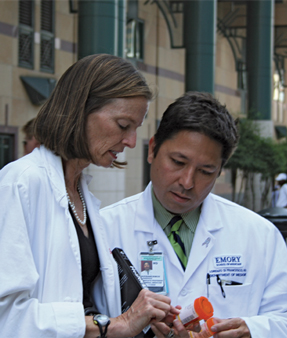Med school debt becomes budgeting burden for primary care
A newly minted primary care physician graduates with a budget that leaves him or her $800 in the red each month. Compared to their subspecialist counterparts, the debt leaves primary care physicians feeling undervalued, especially since they value their work to be as hard and as important.
It will come as no surprise to most internists that choosing primary care as a specialty has a negative impact on a doctor's earnings. But a recent study has more precisely quantified the financial situation facing physicians entering primary care practice today.
Researchers at Dartmouth Medical School created a model of a young primary care physician's finances. Using the average starting salary for a U.S. primary care physician ($130,000) and a medical school debt of $162,500, a monthly budget for this hypothetical family physician or general internist was calculated.

The budget included about $2,200 for loan payments, $900 for retirement savings, $1,700 for mortgage and other home expenses, $2,000 for children's college savings, and another $2,000 for other expenses. Unfortunately, at the end of the month, that budget left the new primary care doc $800 in the hole. By contrast, the same budgeting calculations showed that a new psychiatrist or radiologist would have a monthly surplus of more than $600 or $8,400, respectively. A table comparing monthly budgetary shortfalls is Table.
The findings, titled “Economic Impact of a Primary Care Career: A Harsh Reality for Medical Students and the Nation,” were published in Academic Medicine in November 2010. The study's lead authors, Martin Palmeri, ACP Associate Member, MBA, and Catherine Pipas, MD, spoke to ACP Internist about the implications for primary care physicians and the U.S. health care system.
Dr. Palmeri is a fellow and instructor of hematology/oncology and Dr. Pipas is professor and vice chair of community and family medicine, both at Dartmouth Medical School.
Q: What motivated you to undertake this study?
A: Dr. Palmeri: I did a primary care residency in internal medicine. My first year out, I did a hospitalist job here at Dartmouth. One of the things I did after starting the position was I created a family budget. I realized that, based on my starting salary out of residency, I wasn't going to be able to meet a lot of the savings and investing goals that were necessary for retirement and my children's college education. I found that interesting, because I went to one of the cheapest medical schools in the country and had no medical student debt coming out. What bothered me was that I had a lot of friends who had $200,000 to $300,000 worth of debt. If I was having trouble meeting my savings and investing goals, what do other people face when they pursue primary care careers and they have significant debt? How far behind are they potentially?
Dr. Pipas: Having spent my career really around the idea of supporting students entering careers in primary care, it was of great interest to me to try to increase the awareness of this disconnect between wanting higher quality and lower cost and better access. [We know] that primary care can provide some of that, but we're not creating a field that students really want to go into—the best and the brightest, such as [Dr. Palmeri] and others. We're losing those students who are motivated for the right reasons to enter primary care, but they're feeling, “Hey wait, this actually might not allow me to be comfortable financially.”
Q: When physicians do choose to enter primary care, how do you think they deal with these financial constraints?
A: Dr. Palmeri: I discovered, talking to my friends in primary care and physicians who've practiced primary care for several years, that most people don't realize that there are these financial constraints early in their career. A lot of people tell me that when they get into their 40s—their kids are getting closer to college, and they're beginning to think about retirement—they sit down with their financial planner and they realize, “I've been undersaving for my retirement. I've been undersaving for my children's education.” Then you're playing catch-up. I think a lot of physicians don't quite realize that because of their prolonged training, they're starting the entire savings process late in their careers. A three- to five-year delay in savings for retirement and your children's education can potentially result in having to double your investments in order to catch up.
Q: Are there any data on how your findings would compare to statistics for other specialties or other professions?
A: Dr. Palmeri: I don't think a lot of people have looked at what are the implications for this in other specialties. The length of some training programs extends for six, seven, eight years. This could significantly increase what you have to do to catch up. In a lot of specialties, I think they're going to find these same financial constraints.
Dr. Pipas: Bill Weeks [William B. Weeks, MD, psychiatrist and researcher from Dartmouth] has done some studies looking at different specialties. I believe he's studied medicine, law, dentistry and business in general, and on average, medicine came out with the lowest centralized match down the line—longer training with higher loan repayment compared to any of the other fields.
Q: Do you think finances are affecting medical students' choice of specialty?
A: Dr. Palmeri: There's been some interesting publications that show that students with higher levels of debt are less inclined to pick primary care fields. There was also a study published in Academic Medicine by Kent DeZee [February 2011]. He asked medical students, “What would it take for you to reconsider your specialty choice?” in terms of financial incentives. He found that about 20% of people who were considering specialties would consider primary care with a fairly small financial incentive.
Q: How should such financial incentives be structured—reduced debt, higher salaries?
A: Dr. Palmeri: I think getting medical student debt under control is a very big issue. I saw an unpublished report that medical school tuition has been going up 7% to 10% a year in the last 10 years. At this point, about 20% of medical students have debt over $200,000. [That percentage] has nearly doubled from five years ago. We need to find some way to control these rising educational costs and I think we need some novel debt repayment programs out there to encourage students to go into primary care.
Dr. Pipas: I agree completely, and I also think it's the idea of showing value for primary care. That really means starting to align payment with the things that we value. We're not really paying for things that promote quality and appropriate utilization and continuity. We're not paying for the metrics that we say are important now. We're still paying for the old metrics about quantity.
Dr. Palmeri: I looked at another report that showed that primary care physician salary in eight of the last 10 years has grown at a rate lower than inflation, so there's been actually primary care reimbursement erosion. That's another issue that needs to be considered, when we're beginning to see inflation in medical student debt costs.
Dr. Pipas: Looking at [primary care] physicians who are in the system, nobody feels like they need to be making $700,000, but what feels disconnected and what feels unvalued is that they're making so much less than their counterparts in specialties. They believe they're working as hard or doing as important work.
Q: Would this balancing require reductions in payments to other specialties?
A: Dr. Pipas: I'm not proposing that we don't pay specialists what their value is, but I am acknowledging that there is a fixed pot of money and our country is spending way too much on health care so that pot has to be reassessed. I think that the real place to start is not necessarily in those that are out there and earning, but to align from the GME [graduate medical education]. Look at the bottleneck and say, “What exactly do we need in terms of balance, ratios of physicians going forward?”
If you believe that the country should be built on a strong infrastructure of primary care, then you've got to figure out what that ratio is and it has to be done at a national level with the GME slots and other things aligned. If you believe, like other countries—England and others—that it should be a 50% primary care base, then you've got to get all of payment in alignment to making that happen. Our country's about 30% [primary care physicians], as is our institution. If that's not sufficient to provide the highest quality care for our population and our nation, then we've got to change that.




